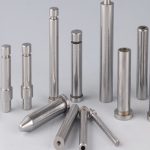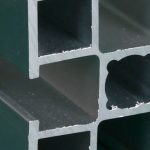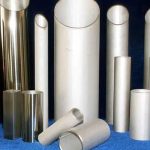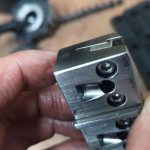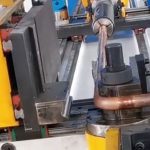Deprecated: get_settings is deprecated since version 2.1.0! Use get_option() instead. in /www/sites/alloy.wiki/index/wp-includes/functions.php on line 4862
Here are some of the key features and characteristics of welded aluminum tubes used in heat exchangers:
- Aluminum Alloys: Welded aluminum tubes for heat exchangers are typically made from aluminum alloys, such as 3003, 6061, and 6063. These alloys offer a balance of strength, corrosion resistance, and thermal conductivity, making them suitable for heat transfer applications.
- Lightweight: Aluminum is a lightweight material, making it easy to handle and install in heat exchangers. Its low density reduces the overall weight of the heat exchanger, which can be beneficial in various applications.
- High Thermal Conductivity: aluminum nitride ceramic led lighting parts has excellent thermal conductivity, allowing for efficient heat transfer within the heat exchanger. This property ensures that heat is rapidly exchanged between the fluid or gases passing through the tubes.
- Corrosion Resistance: Aluminum naturally forms a protective oxide layer on its surface, which provides resistance to corrosion. However, in certain aggressive environments, such as those with high levels of acidity or alkalinity, additional surface treatments or coatings may be required to enhance corrosion resistance.
- Welded Construction: The tubes are fabricated using welding techniques, such as TIG (Tungsten Inert Gas) or MIG (Metal Inert Gas) welding, to create strong and leak-proof joints. Welded construction ensures that the tubes can withstand the pressure and thermal stresses encountered in heat exchanger operations.
- Customizable Shapes and Sizes: Welded aluminum tubes can be manufactured in various shapes, including round, oval, or rectangular, to accommodate different heat exchanger designs. They are also available in a range of sizes and lengths to meet specific application requirements.
- Good Formability: Aluminum is highly formable, allowing for the creation of tubes with different geometries, such as enhanced surface features like fins to improve heat transfer efficiency. This formability enables customization for specific heat exchanger designs.
- High Tolerance for Low Temperatures: Aluminum retains its mechanical properties at low temperatures, which can be advantageous in applications where the heat exchanger needs to operate in cold environments.
- Environmentally Friendly: Aluminum is recyclable and environmentally friendly. The recyclability of aluminum helps reduce the environmental impact of heat exchanger production and disposal.
- Cost-Effective: Aluminum is generally cost-effective compared to some other materials used in heat exchangers, like copper or stainless steel. The combination of its affordability and favorable thermal properties makes it a popular choice in many applications.
Features of Seamless Aluminum Tubes for Heat Exchangers
- Aluminum Alloys: Seamless aluminum tubes for heat exchangers are typically made from aluminum alloys, such as 3003, 6061, and 6063. These alloys offer a balance of strength, corrosion resistance, and thermal conductivity, making them suitable for heat transfer applications.
- Seamless Construction: Seamless aluminum tube laser cutting stainless steel 316 round pipe are manufactured without any welded joints or seams. This seamless construction eliminates the risk of leaks at the welds and enhances the tubes’ overall integrity.
- High Thermal Conductivity: Aluminum has excellent thermal conductivity, allowing for efficient heat transfer within the heat exchanger. Seamless tubes are particularly effective in applications where uninterrupted and smooth heat transfer is crucial.
- Corrosion Resistance: Aluminum naturally forms a protective oxide layer on its surface, providing resistance to corrosion. However, in certain aggressive environments, additional surface treatments or coatings may be required to enhance corrosion resistance.
- Customizable Shapes and Sizes: Seamless aluminum tubes can be manufactured in various shapes, including round, oval, or rectangular, to accommodate different heat exchanger designs. They are also available in a range of sizes and lengths to meet specific application requirements.
- Good Formability: Aluminum is highly formable, allowing for the creation of tubes with different geometries, such as enhanced surface features like fins to improve heat transfer efficiency. This formability enables customization for specific heat exchanger designs.
- High Tolerance for Low Temperatures: Aluminum retains its mechanical properties at low temperatures, which can be advantageous in applications where the heat exchanger needs to operate in cold environments.
- Environmentally Friendly: Aluminum is recyclable and environmentally friendly. The recyclability of aluminum helps reduce the environmental impact of heat exchanger production and disposal.
- Cost-Effective: Aluminum is generally cost-effective compared to some other materials used in heat exchangers, like copper or stainless steel. The combination of its affordability and favorable thermal properties makes it a popular choice in many applications.
Choosing the Right Tube for Your Application
-
Material Selection:
- Consider the environment: Assess the operating conditions, such as temperature, pressure, and the presence of corrosive substances, to determine the tube material that can withstand these conditions. Common materials include metals (e.g., steel, aluminum, copper), plastics (e.g., PVC, PEX), and composite materials.
-
Size and Dimensions:
- Determine the required size: Choose a tube size (diameter and thickness) that can handle the flow rate, pressure, and load for your application. Consider compatibility with fittings and connectors.
- Evaluate length and shape: Decide whether straight tubes, coils, or customized shapes are needed to fit within the available space and to facilitate the desired fluid or gas flow.
-
Surface Finish and Coatings:
- Consider surface finish: Depending on the application, you may need tubes with specific surface finishes, such as smooth, polished, or textured, to optimize fluid flow or prevent fouling.
- Evaluate coatings: Some tubes may require coatings to enhance corrosion resistance, reduce friction, or improve thermal conductivity.
-
Mechanical Properties:
- Assess strength and rigidity: Choose a tube 3d printing material that provides the necessary mechanical strength and rigidity to withstand the loads and stresses associated with your application.
- Flexibility and ductility: In applications where flexibility is crucial, select materials that can bend or flex without breaking.
-
Thermal Properties:
- Thermal conductivity: For heat transfer applications like radiators or heat exchangers, consider materials with high thermal conductivity to maximize energy efficiency.
-
Chemical Compatibility:
- Compatibility with fluids or gases: Ensure that the tube material is compatible with the substances it will transport to prevent chemical reactions or contamination.
-
Weight and Cost:
- Balance weight and cost: Choose a material and tube size that align with your budget while meeting the application’s performance requirements.
-
Manufacturing Process:
- Consider the tube manufacturing process: Decide whether seamless or laser welding of large tubes are suitable for your application. Seamless tubes are often preferred when leak-proof integrity is critical.
-
Regulatory Compliance:
- Ensure compliance: Verify that the chosen tube material and construction meet relevant industry standards and regulations for your specific application.
-
Maintenance and Longevity:
- Evaluate maintenance requirements: Some materials or coatings may require less maintenance, which can be cost-effective over the long term.
- Consider expected service life: Choose tubes that will provide the desired service life while considering factors like wear and tear.
-
Customization:
- If off-the-shelf options do not meet your requirements, consider customized tube solutions that can be tailored to your specific needs.
Link to this article:Features of Welded Aluminum Tubes for Heat Exchangers
Reprint Statement: If there are no special instructions, all articles on this site are original. Please indicate the source for reprinting:Alloy Wiki,thanks!^^


